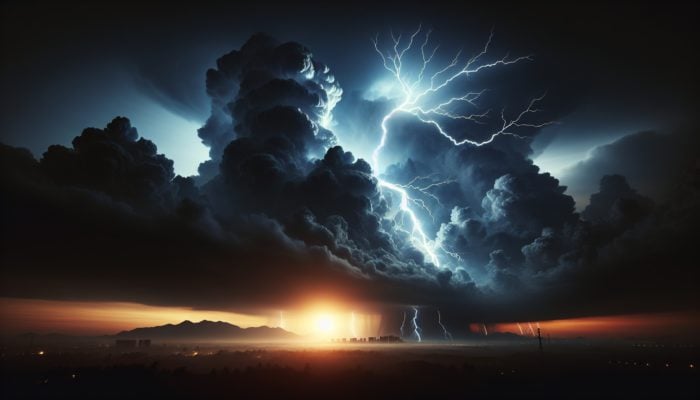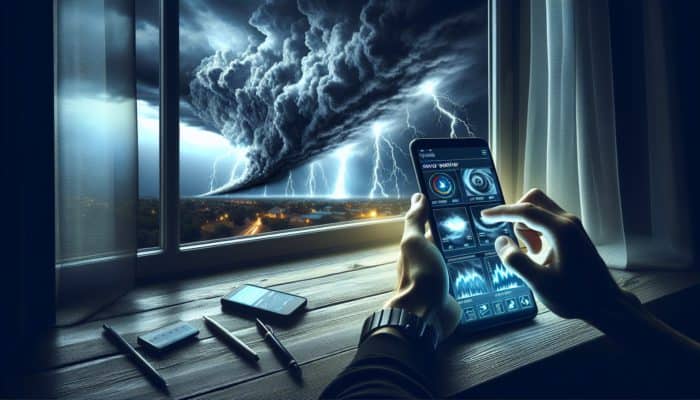Comprehending the Dynamics of Lightning Strikes
Surviving a Lightning Strike: Lightning is a breathtaking natural phenomenon that possesses the potential to become lethal in mere moments. Gaining an understanding of the underlying causes of lightning, the diverse types that manifest, and their impacts on human beings is of utmost importance for anyone wishing to fortify their safety during storms. An informed individual can take necessary precautions, thereby significantly reducing the risk of being affected by this awe-inspiring yet dangerous occurrence. It’s essential to navigate the treacherous conditions that accompany thunderstorms effectively.
Unraveling the Causes Behind Lightning Formation

Lightning emerges from the complex interplay of atmospheric electricity, predominantly during thunderstorms. This electrical discharge takes place when oppositely charged regions within a cloud or between a cloud and the ground accumulate sufficient energy to produce a striking electrical current. The scientific principles behind this phenomenon are rooted in the collisions between water droplets and ice particles within clouds, which lead to the separation of electrical charges. This process results in a concentration of positive charges at the cloud’s upper regions and negative charges at the lower levels, setting the stage for a lightning strike to occur.
Regions that experience frequent thunderstorms, such as tropical areas or regions like Florida, witness spectacular displays of lightning, often referred to as “heat lightning.” Understanding the meteorological conditions that trigger lightning is vital for surviving a lightning strike. Utilising meteorological apps and forecasts can provide crucial alerts about impending storms, enabling individuals to implement appropriate safety measures before the skies become ominous. Being proactive can significantly lower the chances of encountering dangerous lightning conditions.
Exploring the Various Types of Lightning Strikes
The realm of lightning is as varied as it is perilous. There are multiple types of lightning strikes, each carrying distinct risks and consequences. The four primary categories are direct strikes, side flashes, ground currents, and conductor strikes. Each category presents unique dangers that individuals must be aware of to ensure their safety.
A direct strike occurs when lightning makes direct contact with a person or object, often resulting in fatal injuries or immediate death. A side flash occurs when lightning strikes an object nearby and then jumps to a person standing nearby. Ground currents travel through the earth’s surface and can affect individuals who may not be near the original strike point but remain in the vicinity. Lastly, the conductor strikes target objects such as trees, buildings, or power lines, which can facilitate the flow of electricity.
Understanding these types of strikes is crucial for anyone who enjoys outdoor activities, including hikers, campers, or sports enthusiasts. Being well-informed about the most hazardous forms of lightning can greatly enhance your chances of surviving a lightning strike, ultimately allowing you to enjoy your outdoor adventures with greater confidence and safety.
Understanding the Frequency of Lightning Strikes
Lightning strikes are far more prevalent than many individuals might realise. Statistically, approximately 240,000 lightning strikes occur globally each day, culminating in billions of strikes annually. Areas characterised by high thunderstorm activity, such as the Caribbean or Southeast Asia, experience a higher frequency of strikes, while other regions may witness fewer occurrences, albeit still dangerous ones. This frequency is a critical factor to consider when assessing safety.
Being aware of the frequency of lightning strikes is essential for personal safety. For example, outdoor enthusiasts or individuals residing in regions prone to lightning strikes must stay alert and prepared, especially during the peak months of thunderstorm activity. Recognising that lightning is an ever-present danger enables individuals to make informed choices regarding when to seek shelter and how to prepare for storms effectively.
Assessing the Effects of Lightning on Human Health
The consequences of lightning strikes on humans can be catastrophic. The most immediate effects include cardiac arrest, severe burns, and neurological damage. Survivors of lightning strikes often contend with long-term health complications such as memory loss, chronic pain, and psychological trauma. These impacts can drastically alter one’s quality of life, necessitating ongoing care and support.
According to the National Lightning Safety Institute, around 90% of lightning strike victims survive; however, many face significant health challenges in the aftermath. The type and severity of injuries sustained depend on various factors, including the individual’s proximity to the strike and the path the electrical current takes through their body. Recognising the potential for severe injury underscores the necessity of implementing safety measures during storms to mitigate risk effectively.
Implementing Lightning Safety Measures
To mitigate the risks associated with lightning strikes, it is essential to implement comprehensive safety measures. A fundamental rule is to avoid open fields, tall trees, and bodies of water during thunderstorms, as these areas increase exposure to lightning, rendering individuals more vulnerable to strikes.
In contrast, seeking shelter inside a substantial building or a fully enclosed vehicle offers the best protection. While no location is entirely safe during a lightning storm, adhering to these precautions can significantly reduce risks. Awareness and preparedness serve as your best allies against the unpredictable nature of lightning, enhancing your ability to respond effectively when storms arise.
Strategically Preparing for an Upcoming Storm
Preparation plays a pivotal role in ensuring safety during thunderstorms. By taking a proactive approach, you can significantly reduce your chances of being struck by lightning and minimize risks associated with severe weather conditions. This preparation involves understanding the storm’s potential impact and implementing appropriate measures to safeguard yourself and your loved ones.
Staying Updated on Weather Conditions

Remaining informed about weather conditions is crucial for anyone seeking protection from lightning strikes. Utilising reliable weather apps or services can provide real-time updates on approaching storms and potential lightning risks. Many apps now offer alerts that notify users when severe weather is approaching, giving them ample time to seek shelter and take necessary precautions.
In addition to using apps, it is wise to monitor local weather reports and radar images to closely track storm movements. It is also prudent to have a backup method of communication in the event of power outages. Staying vigilant and informed can mean the difference between safety and disaster when storms roll in unexpectedly.
Formulating a Comprehensive Safety Plan
Creating a thorough safety plan is vital for minimising exposure to lightning risks effectively. Your plan should incorporate specific indoor and outdoor safety measures to implement during a lightning storm.
In outdoor environments, identify safe locations for gathering during storms, such as nearby buildings or vehicles that provide shelter. Indoors, ensure that all family members are aware of the safest places to seek refuge. Regular family discussions can reinforce these plans, ensuring everyone understands the importance of finding protection from lightning.
A well-structured safety plan acts as a roadmap, guiding individuals and families through the chaos of a storm and significantly enhancing their chances of surviving a lightning strike.
Investing in Essential Safety Gear
Equipping yourself with essential safety gear can drastically reduce risks during thunderstorms. Items such as rubber-soled shoes offer a non-conductive barrier, while non-conductive umbrellas can shield you from direct strikes. Investing in high-quality gear not only boosts safety but also cultivates a culture of preparedness within your household.
Additionally, creating personal emergency kits that include essential items such as flashlights, batteries, and first aid supplies ensures you are ready to tackle any challenges that may arise during a storm. Being well-prepared with the right equipment ensures safety and enhances your peace of mind when storms are imminent.
Securing Outdoor Items Before Storms
Loose outdoor items can present serious hazards during storms, particularly when high winds accompany lightning. Taking the time to secure or bring in items such as garden furniture, decorations, and tools can prevent these objects from becoming dangerous projectiles during inclement weather.
A well-maintained and organised yard not only enhances safety but also contributes to the aesthetic appeal of your property. Make it a routine to inspect your outdoor spaces before storms, ensuring that everything is safely stowed away. This proactive measure not only enhances your safety unexpectedly but also prepares you for any weather-related issues that may arise unexpectedly.
Implementing Indoor Safety Measures
Once storms hit, knowing how to remain safe indoors can significantly reduce the risks associated with lightning strikes. Proper awareness and precautionary actions can help safeguard your home and loved ones during turbulent weather conditions.
Steering Clear of Conductive Appliances
During a lightning storm, it is imperative to avoid conductive appliances. Many electrical devices pose a substantial risk, as they can become nearby conduits for the city if a nearby strike occurs. Plumbing also presents a concern, as water pipes can conduct electricity, increasing the likelihood of injury.
Maintaining a safe distance from these hazards can drastically lower your risk of injury during a storm. Educate all household members about the dangers of using electronic devices or touching metal fixtures during thunderstorms, ensuring that everyone understands the importance of exercising caution during such events.
Identifying Safe Locations Inside Your Home
Recognising safe locations within your home is a crucial aspect of indoor safety during thunderstorms. Seek shelter in buildings equipped with lightning rods or sturdy structures that can withstand electrical impacts. Areas such as basements or interior rooms, away from windows, provide better protection during storms.
Avoiding open areas and windows reduces the chances of being harmed by stray electrical currents or debris. The more informed you are about safe spaces, the better your chances of surviving a lightning strike and ensuring the safety of your household during severe weather events.
Protecting Your Electronics from Lightning Damage
Lightning can cause significant damage to electronic devices, resulting in irreversible harm due to power surges. Unplugging devices during storms is a simple yet effective measure to safeguard your electronics from potential damage.
Consider investing in surge protectors for sensitive equipment, such as computers or televisions, to add an extra layer of protection. Protecting your electronics not only conserves your finances but also ensures that you remain connected and informed during severe weather conditions, allowing for better preparedness and response.
Preparing an Emergency Kit for Storms
Assembling a well-rounded emergency kit is a vital preparatory step for storms. Ensure your kit is stocked with essential items, including flashlights, batteries, a first aid kit, and bottled water. Being prepared for power outages and emergencies during storms guarantees that you are equipped to handle any situation that may arise.
Regularly check your emergency kit to replenish outdated items and keep it updated. A well-stocked kit can serve as a lifeline during a storm, enhancing your chances of surviving a lightning strike and maintaining safety within your household.
Educating Household Members on Safety Protocols
Education is an invaluable tool when it comes to lightning safety. Teach everyone in your home about indoor safety protocols and the importance of adhering to them during thunderstorms.
Host family discussions or practice drills to reinforce knowledge about the actions to take when storms strike. The more informed your household members are, the better prepared you will all be to face the challenges presented by severe weather together, enhancing your overall safety.
Implementing Outdoor Safety Strategies
When storms approach, outdoor safety becomes paramount. Knowing how to respond when caught outside can significantly enhance your chances of surviving a lightning strike and ensuring your well-being during tumultuous weather.
Quickly Finding Shelter During a Storm
In a lightning storm, swiftly locating shelter is essential. Low-lying areas and dense forests can provide temporary refuge, reducing your exposure to lightning. Seek out buildings or vehicles whenever possible, as these structures offer better protection than remaining exposed to the elements.
Always have a clear plan in mind regarding where to find shelter in your vicinity. Whether hiking a trail or enjoying a day at the beach, knowing your options can be lifesaving in the event of an unexpected storm.
Staying Clear of Tall Structures
Maintaining a safe distance from tall objects, such as trees or telephone poles, is a critical safety measure during thunderstorms. These structures are more likely to attract lightning, putting you at increased risk if you are nearby.
While outdoors, be aware of your surroundings and avoid areas where tall objects are prevalent. Instead, opt for open fields or lower terrains, as these positions can reduce your chances of being struck directly by lightning, thereby enhancing your safety.
Adopting Proper Body Positioning Outdoors
Suppose you find yourself outdoors during a lightning storm and cannot seek shelter. In that case, your body positioning can make a significant difference in your safety. Crouching low to the ground with minimal contact can mitigate the risk of ground current strikes.
Keep your feet close together and squat low, minimising your contact with the ground. This positioning helps lower your overall profile while also reducing the chances of electrical currents travelling through your body during a storm.
Taking Immediate Actions Following a Lightning Strike
The moments following a lightning strike can be chaotic and disorienting. Knowing the appropriate actions to take immediately after can be critical for ensuring safety and well-being.
Evaluating Personal Injury After a Strike
After a lightning strike, assessing personal injury is a crucial first step. Check yourself and those around you for burns, signs of cardiac arrest, or neurological symptoms. If anyone is unresponsive, administering CPR and seeking immediate medical attention is imperative.
Recognising the symptoms of injury can be challenging, especially in the aftermath of a strike. Remain calm and focus on providing first aid to those affected while awaiting the arrival of emergency services, as your actions can be vital in ensuring their survival.
Providing Assistance to Others
If it’s safe to do so, assist others who may have been struck by lightning. Prioritise those in urgent need of care, such as individuals experiencing cardiac arrest. Call emergency services immediately, relaying clear details about the situation to ensure swift assistance.
Offering help can be a pivotal aspect of surviving a lightning strike. Your actions could save a life, making it essential to remain composed and act quickly in emergencies, as your prompt response can significantly impact the outcome.
Continuing Safety Measures Post-Strike
After a lightning strike, it is crucial to remain cautious, as storms can produce multiple strikes. Stay sheltered until the storm has completely passed. Continue monitoring weather alerts for any changes in conditions or additional updates. Maintain an accessible and ready emergency kit, ensuring it remains ready for use. Remaining vigilant ensures that you are prepared for any unforeseen circumstances that may emerge in the aftermath of a storm, helping you navigate potential dangers effectively.
Long-term Health Considerations Following a Lightning Strike
Surviving a lightning strike is a life-altering experience, and the path to recovery can be complex and ongoing. The aftershock presents an event that often brings with it numerous challenges that survivors must navigate.
Understanding Potential Health Effects
Individuals who have survived lightning strikes may face a range of long-term health effects, including memory loss, chronic pain, and psychological trauma. The physical ramifications of a strike can lead to debilitating conditions that necessitate extensive rehabilitation and ongoing care, which can be both challenging and exhausting.
Recognising these potential health effects allows survivors and their families to seek appropriate medical treatment and support. Acknowledging that the recovery journey may be lengthy equips individuals with the mental fortitude needed to face ongoing challenges, ensuring they have the resources necessary for their long-term well-being.
Importance of Regular Medical Follow-Up
Regular medical check-ups are essential for anyone who has survived a lightning strike. Ongoing assessments help monitor and manage any lasting effects from the strike, ensuring that any complications are addressed promptly and effectively.
Engaging in open dialogue with healthcare professionals about experiences and symptoms can provide valuable insight and guidance for managing long-term health considerations. A proactive approach to healthcare can significantly enhance the quality of life for survivors post-stroke, ensuring they receive the care they need.
Accessing Mental Health Support
The emotional and psychological impact of surviving a lightning strike can be profound and pervasive. Survivors may grapple with anxiety, depression, or post-traumatic stress disorder (PTSD). Seeking therapy or counselling can provide a safe space for individuals to process their experiences and emotions, allowing them to work through their trauma in a supportive environment.
Connecting with support groups or mental health professionals familiar with trauma can be immensely beneficial. These resources foster resilience and equip survivors with the tools necessary to navigate the mental health complexities that may arise following a lightning strike, aiding in their overall recovery.
Empowering Others Through Lightning Safety: Effective ways to enhance lightning safety include sharing knowledge and experiences with others, thereby fostering a culture of preparedness and awareness.
Utilising Personal Experiences for Education
Using personal experiences to educate others about the dangers and safety measures related to lightning can have a profound impact. Sharing your stories can raise awareness of the risks associated with storms and underscore the significance of preparedness.
Consider speaking at community events, schools, or local organisations to impart your insights. Your lived experiences can empower others to take lightning safety seriously, potentially saving lives in the future by encouraging proactive measures.
Advocating for Lightning Safety Awareness
Encouraging communities to implement safety protocols and education programmes regarding lightning risks is essential for fostering a culture of awareness and preparedness. Advocate for local initiatives that focus on lightning safety education within schools and community centres, emphasising the importance of understanding the dangers posed by thunderstorms.
Promoting safety awareness through social media platforms or community outreach can effectively reach a broad audience, reinforcing the necessity of taking lightning risks seriously and enhancing communal safety.
Leveraging Educational UtiUtilizedfety
Take advantage of existing educational resources to enhance your understanding and awareness of lightning safety. Numerous organisations provide materials, guides, and online courses centred on lightning safety, which can be invaluable for community education.
Distributing these resources in your community can help inform individuals about the risks associated with thunderstorms and empower them to take proactive safety measures. Utilising technology to share information makes it accessible to a wider audience, further enhancing public safety.
Frequently Asked Questions about Lightning Safety
What actions should I take if I see lightning?
Seek shelter immediately in a substantial building or vehicle. Avoid open areas, tall objects, and bodies of water to minimise risk.
How can I determine if a storm is approaching?
Monitor weather apps or services for alerts regarding thunderstorms. Pay attention to darkening skies and increasing winds, which often signal an imminent storm.
Can lightning strike the same location multiple times?
Yes, lightning can and often does strike the same location multiple times, particularly in tall structures such as skyscrapers and radio towers, which are more susceptible to strikes.
Is it safe to use my phone during a storm?
Avoid using wired phones during a lightning storm, as they can pose risks. Cell phones are generally safer, but it’s still best to refrain from using conductive devices whenever possible.
What are the signs of a lightning strike injury?
Signs may include burns, confusion, irregular heartbeats, and loss of consciousness. Immediate medical attention is necessary if you suspect an injury from a lightning strike.
Can I swim during a lightning storm?
Swimming during a lightning storm is extremely dangerous, as water conducts electricity, significantly increasing the risk of being struck by lightning.
What should I include in my emergency kit?
Your emergency kit should contain flashlights, batteries, a first aid kit, bottled water, and non-perishable food items to ensure readiness during emergencies.
How can I prepare my outdoor space for a storm?
Secure or bring in any loose items that could become hazardous during high winds, ensuring that your yard is free of debris and safely stowed away.
What is the safest place to be during a lightning storm?
The safest place during a lightning storm is indoors, in a sturdy building or a fully enclosed vehicle that protects from strikes.
How likely is it to survive a lightning strike?
Approximately 90% of individuals struck by lightning survive; however, many may encounter severe long-term health issues. Immediate medical attention is crucial for all victims.
Explore more with us on X!
Post-Disaster Bartering: Essential Strategies
Exploring the Concept of Post-Disaster Bartering What Is the Concept of Post-Disaster Bartering? Post-Disaster Bartering: Post-disaster bartering refers to the exchange of goods and services that occurs when conventional currency systems collapse due to catastrophic events, such as natural disasters, economic crises, or societal upheavals. During these critical moments, individuals and communities utilise the resources […]
Hurricane Generator Use: Powering Through Storms
Maximising the Benefits of Hurricane Generator Usage What Exactly Are Hurricane Generators? Hurricane Generator Use: Hurricane generators are advanced power supply devices specifically engineered to deliver electricity during extreme weather events, particularly during hurricanes, when standard power infrastructures may fail. These robust machines ensure that both residential and commercial establishments receive the power they need, […]
Emergency Family Plan: Universal Preparation Guide
Comprehensive Elements to Include in Your Family Emergency Plan Effective Communication Strategies for Emergencies Emergency Family Plan: Establishing effective communication strategies is absolutely vital for ensuring that family members remain connected and informed during emergencies. It’s crucial to have clear, reliable methods in place that everyone understands and can utilise effortlessly. This encompasses traditional communication […]
Survival Water Bottles: Essential Gear for Emergencies
Why Survival Water Bottles are Essential for Emergency Preparedness Understanding the Significance of Hydration in Crisis Situations Survival Water Bottles: Maintaining hydration is vital for ensuring optimal bodily functions during emergencies. In scenarios where access to clean water is limited, sustaining proper hydration is crucial in preventing health complications associated with dehydration, which can include […]








It’s fascinating how the intricacies of lightning formation highlight both the power and unpredictability of nature. I’ve always been captivated by thunderstorms, yet knowledge about their dangers has definitely changed how I experience them. For example, understanding that the best place to be during a storm isn’t necessarily indoors, but also away from windows and electrical appliances, has made me think twice about my safety routines.
I found your exploration of lightning strikes fascinating, particularly how you highlighted the importance of understanding the mechanisms behind them to enhance safety. Growing up in a region prone to thunderstorms, I’ve always been both amazed and fearful of lightning. I remember the first time I witnessed a strike close to home; it was a powerful reminder of nature’s unpredictability.
Your exploration of lightning strikes really resonates with me, especially as someone who has always viewed storms with both fascination and caution. It’s incredible how such a powerful natural phenomenon can remind us of the delicate balance between beauty and danger. I remember a time during a particularly intense summer storm, watching the way lightning illuminated the sky while simultaneously feeling a deep respect for its power.